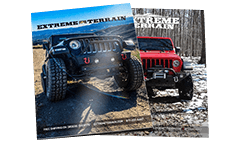
Talk to a Wrangler Sales Tech
1-877-870-8556
M-F 8:30A-11P, Sat-Sun 8:30A-9P

Choosing the Right Shocks for your Jeep
Shocks keep the tires firmly planted so you can drive safely, and they move up and down to adjust to the road and trail conditions...When should your shocks be changed?
Shocks have been around for decades, almost 100 years. The first shocks were known as “lever shocks”, and then just a little later on, they became the tube shocks we’re familiar with today. A good shock can help with better handling, vehicle control, stability, and safety.A typical tube shock (or strut/coil over the unit, etc.) has a very important job. That’s to hold the tires in contact with the road and dampen vibration. If you didn’t have a shock in place, your tire would bounce out of control up and down and that would be a serious vibration you would feel inside. It would also probably add premature tire wear, such as “cupping”, which can easily ruin a $ 400.00 tire in no time.Shocks keep the tires firmly planted so you can drive safely, and they move up and down to adjust to the road and trail conditions. They're basically a giant hydraulic piston.When should your shocks be changed?There are TWO basic scenarios on when you would change a shock: Upgrading - There are times, especially for 4x4 and Jeep owners, when you need to replace and upgrade your stock shocks because you need something with better dampening, or you’ve modified the vehicle. Such as adding a lift to your Jeep. You now need a shock that is longer and has more travel to accommodate the suspension lift. But also, you may need a more powerful shock design with more dampening force.Shocks are worn out, broken, or damaged - If your shocks are worn out, you’ll usually know because their dampening ability has disappeared, and they no longer get the job done. Typically this is because an outer seal has failed (to where the internal gas and oil have escaped out), or an internal seal has worn out (causing the oil to bypass the piston improperly). When the oil escapes on the outside, it can cover the shock body and accumulate a lot of dirt and grime, which is easy to spot just by looking at the shock. Another common failure is the bushings on the shocks. Stock shocks usually use rubber bushings, and they can crack, warp, or just plain fall out. This can give you an odd noise or clunking sound. Another sign that it’s time to replace them.If your handling has been degrading, or your Jeep doesn’t handle or feel stable like it used to, check our your shocks.What are the most common shock designs?There are TWO basic designs:Twin Tube Shock Low-Pressure Design -These are usually what’s stock on any car or truck, barring any special editions or vehicles (such as a Z71 Chevy, or a Ford Raptor) etc.). In a twin tube shock, the oil and gas (nitrogen) are mixed together (some really cheap and older shocks have no nitrogen gas at all, and are better known as “hydraulic” shocks). These are fine when used for average driving, but if worked to hard, they will have aeration (cavitation) inside, which means they get foam inside. Foaming is not a good resistor like the oil, so the shocks will “fade” and the dampening ability of the shock goes away. They also generate a lot of heat. That’s why twin tube shocks sometimes have really fat shock bodies. The manufacturer is trying to cram as much oil inside as they can because of aeration issues. (Note that nitrogen is a non-flammable gas).Mono-Tube Shock High-Pressure Design -Almost all performance shocks are a monotube, and that’s because they were first primarily used in racing. They are under very high-pressure inside (around 200 psi to 360 psi). The oil and nitrogen gas are in two separate chambers. The high pressure is important because it helps prevent bubbles and aeration from forming. This makes the shocks consistent with their dampening ability and keeps them from fading. They also run cooler (even more so with an external reservoir).If you are running a larger tire, you want even more force to keep those tires under control, and a monotube would have the power to help dampen the tires and the suspension. You will get better stability, both off road and at highway speeds.Almost all off-road race teams are running monotubes, so if they can stand up to that beating, they should work just fine on your Jeep.Note that the higher gas pressure inside the monotube does not make the shock “stiffer”. That’s done with valving, which is internal when the shock is made (unless you are using a shock with adjustable firmness settings, which we carry). Most of the shock companies valve their shocks for the expected use and the vehicle they fit. So it’s likely that a CJ shock will have a totally different valving that a JK shock.There are other types of shocks, namely coil over shocks (which are actually more like an automotive strut), external reservoir shocks, and adjustable shocks, etc. But at their heart, they will all still be a twin-tube or monotube design.So which shock is best?That depends on what kind of driving you plan on doing. Twin-tube shocks are fine for normal driving. But sometimes modifications force you into upgrading a shock, even if it’s just longer than the stock ones. But if you plan on being aggressive off road, and really plan on giving your Jeep a workout at Skyjacker or Rubicon, you may want to go big and get a shock that gives you the best dampening possible.It’s easy for us to help you choose the right shock for your Jeep because we carry so many different brands and types, so let us know. We have the shocks you need.
